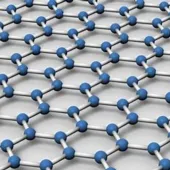Celebrating 20 years of graphene breakthrough
The University of Manchester is celebrating twenty years since scientists, Professor Sir Andre Geim and Professor Sir Kostya Novoselov, first isolated the Nobel Prize-winning ‘wonder material’, graphene.
Scientists knew of the existence of one atom thick, two-dimensional crystal graphene but no one had figured out how to extract it from graphite, until Professor Geim and Professor Novoselov’s groundbreaking work in 2004. Geim and Novoselov frequently held ‘Friday night experiments’, where they would play around with ideas and experiments that weren’t necessarily linked to their usual research. It was through these experiments that the two first isolated graphene, by using sticky tape to peel off thin flakes of graphite, ushering in a new era of material science.
Their seminal paper ‘Electric Field Effect in Anatomically Thin Carbon Films’, has since been cited over 40,000 times, making it one of the most highly referenced scientific papers of all time.
What Geim and Novoselov had achieved was a profound breakthrough, which would not only earn the pair a Nobel Prize in 2010 but would revolutionise the scientific world.
The vast number of products, processes and industries for which graphene could significantly impact all stem from its extraordinary properties. No other material has the breadth of superlatives that graphene boasts:
• It is many times stronger than steel, yet incredibly lightweight and flexible
• It is electrically and thermally conductive but also transparent
• It is the world’s first two-dimensional material and is one million times thinner than the diameter of a single human hair.
Areas for application are vast and include: transport, medicine, electronics, energy, defence, desalination, and construction - concrete and cement - are all being transformed by graphene research. In biomedical technology, graphene’s unique properties allow for groundbreaking biomedical applications, such as targeted drug delivery and DIY health-testing kits. In sport, graphene-enhanced running shoes deliver more grip, durability and 25% greater energy return than standard running trainers – as well as the world’s first graphene car.
Professor Sir Andre Geim said: "Thousands of people are trying to understand how it works. I would not be surprised if graphene gets another Nobel prize or two given there are so many people who believe in this area of research."
At the heart of this ongoing research is The University of Manchester, which has built a model research and innovation community, with graphene at its core. The National Graphene Institute enables academics and their industrial partners to work together on new applications of graphene and other 2D materials, while the Graphene Engineering Innovation Centre accelerates lab-market development, supporting more than 50 spin-outs and numerous new technologies.
CEO of Graphene@Manchester, Professor James Baker, said: “As we enter the 20th anniversary since the first discovery of graphene, we are now seeing a real ‘tipping point’ in the commercialisation of products and applications, with many products now in the market or close to entering. We are also witnessing a whole new eco-system of businesses starting to scale up their products and applications, many of which are based in Manchester."







